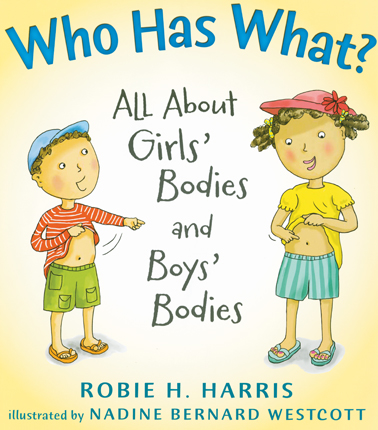| Who has what? : all about girls' bodies and boys' bodies (Let's talk about you and me) Author: Harris, Robie H. | ||
| Price: $6.50 | ||
Summary:
Nellie and Gus learn the physical differences between males and females.
| Illustrator: | Westcott, Nadine Bernard |
Common Core Standards
Grade K → Reading → RI Informational Text → K.RI Key Ideas & Details
Grade K → Reading → RI Informational Text → K.RI Craft & Structure
Grade K → Reading → RI Informational Text → K.RI Integration of Knowledge & Ideas
Grade K → Reading → RI Informational Text → K.RI Range of Reading & Level of Text Complexity
Grade K → Reading → RI Informational Text → Texts Illustrating the Complexity, Quality, & Rang
Grade 1 → Reading → RL Reading Literature → 1.RL Craft & Structure
Grade 1 → Reading → RI Informational Text → 1.RI Key Ideas & Details
Grade 1 → Reading → RI Informational Text → 1.RI Craft & Structure
Grade 1 → Reading → RI Informational Text → 1.RI Integration of Knowledge & Ideas
Grade 1 → Reading → RI Informational Text → Texts Illustrating the Complexity, Quality, & Rang
Grade 1 → Reading → CCR - College & Career Readiness Anchor Standards
Grade 1 → Reading → RI Informational Text → 1.RI Range of Reading & Level of Text Complexity
Reviews:
Kirkus Reviews (+) (07/15/11)
School Library Journal (+) (10/01/11)
Booklist (+) (09/01/11)
The Bulletin of the Center for Children's Books (10/11)
The Hornbook (00/11/11)
Full Text Reviews:
Booklist - 09/01/2011 *Starred Review* Harris’ oft-challenged It’s Perfectly Normal (1994), It’s So Amazing! (1999), and It’s Not the Stork! (2006) each address a different age group of children. This newest outing aims for the youngest set yet (an injury is called “a boo-boo”), though most parents should plan to read the words aloud and offer clarification. As always, Harris’ tone is cheerful and confident, introducing an interracial couple and their two children as they hit the beach, repeating one message: “Every girl has a body. Every boy has a body. Every grown-up has a body.” The kids are not sure “who has what,” which leads to a series of short, clear explanations, with little arrows pointing out each body part, whether they are the same (“cheek,” “chin”) or different. Changing into swimwear provides the opportunity to point out the primary physical differences: “Girls have an opening to the vagina, and an opening where pee comes out.” Unobtrusive X-rays show interior views, while pet dogs are there for further anatomical comparison. Westcott’s bright digital illustrations keep the affair as breezy and nonshocking as possible—just as it should be. Expect the usual outcry, as well as the usual demand. - Copyright 2011 Booklist.
Bulletin for the Center... - 10/01/2011 Harris has been bringing her comprehensive yet light-hearted approach to sex education to younger and younger children, and unless she has a prenatal audience in mind for the future, here she hits the end of the road. Preschooler Nellie and her younger brother Gus are off with their parents for a day at the beach. The siblings’ chatter turns to bodies, their similarities and differences, and as they make observations about the preponderance of commonality (with, of course, a few striking and important gender differences), the narrator’s voice supplies commentary on how internal and external genitalia may someday figure into motherhood and fatherhood. The particulars of conception are left for another day and another title (quite likely Harris’ own It’s Not the Stork!, BCCB 10/06), and the steady focus on identifying body parts makes the territory below the swimsuits seem little more mysterious or significant than eyes and elbows and ankles. Although the children’s remarks sometimes feel a bit clunky and forced, the beach provides a natural setting for generating “the discussion”: the changing rooms afford the opportunity to check out everybody’s parts as they shimmy in and out of swimwear, while subtly underscoring the privacy altogether appropriate for the, well, altogether. Westcott’s bouncy cartoon cast is thoroughly multicultural, with Nellie and Gus the creamy-skinned offspring of a biracial couple and beachgoers representing just about every demographic under the blazing summer sun. With this appealing new title, families can now choose from among an almost seamless step-up series. EB - Copyright 2011 The Board of Trustees of the University of Illinois.
School Library Journal - 10/01/2011 PreS-Gr 2—This is a straightforward presentation, as told through simple exposition and the dialogue of a young girl and boy who are going to the beach for the day. As the youngsters chat with one another about their similarities and differences, readers are greeted with visually appealing cartoonlike drawings that depict an array of people in various family groupings. As the two children change in their separate cabanas, arrows point to and name the parts of their bodies that distinguish them as male or female. A dog (of the same sex as the child) has crept into each child's cabana so its parts are labeled, too. Correct terminology is used, e.g., vagina, scrotum, penis, ovary, uterus, but Harris does not delve into how these body parts function, and she doesn't address the reproductive process. The book serves as a great way to introduce male and female body parts for anyone not used to discussing or naming them. For a more comprehensive look at body parts, reproduction, and birth, check out Harris's It's Not the Stork! (Candlewick, 2006).—Maggie Chase, Boise State University, ID - Copyright 2011 Publishers Weekly, Library Journal and/or School Library Journal used with permission.



